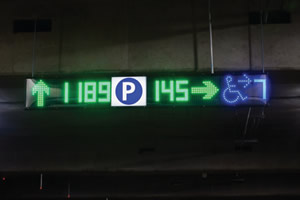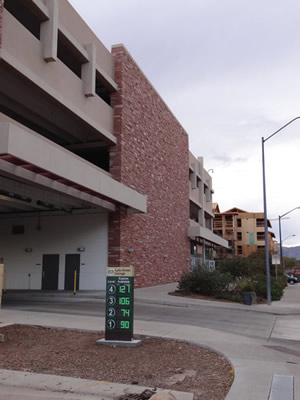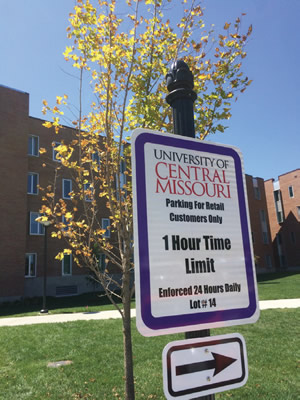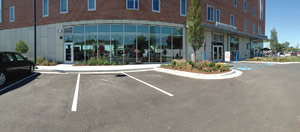Parking Goes Hi-Tech

PHOTO COURTESY OF INDECT USA
Parking is an extraordinarily important asset for most colleges and universities, and it has an enormous impact on the day-to-day lives of students, faculty and staff, particularly those who commute. For some schools, it’s also an important revenue generator. Still others rely on their parking systems to promote alternative transportation or even sustainability. In fact, parking plays many different roles, depending on the unique needs of an individual campus.
In light of the important role that parking plays on most campuses, it shouldn’t come as a surprise that many universities are investing in technologies designed to provide a better parking experience while making parking more manageable. The technology revolution that has transformed our daily lives has reached the parking industry, and colleges and universities are reaping the benefits.
“The parking industry is enjoying unprecedented technological advancement and many of the new technologies that have been introduced in recent years are particularly beneficial to colleges and universities,” says Dan Kupferman, director of Car Park Management Systems for Walker Parking Consultants. “Technology has made parking more efficient, more precise and easier to operate. It’s also making parking more customer-friendly than ever before, which is great news for students, faculty and staff.”
Access and Revenue Control
Parking access and revenue control systems (PARCS) have long been technology staples for colleges and universities. PARCS equipment controls who enters and exits parking facilities, while at the same time managing how users pay. We’ve come a long way from the days when an attendant would collect cash from parkers and promptly put the cash into a cigar box. Today’s PARCS equipment can accept cash, credit cards, student IDs and numerous other credentials.

PHOTO COURTESY OF INDECT USA
RED LIGHT, GREEN LIGHT. Parking facilities are going hi-tech with the installation of parking guidance systems that direct drivers to available spaces.
PARCS is also the cornerstone of one of the most exciting new trends in parking: frictionless parking. Frictionless parking permits drivers to park without interacting with traditional payment systems, and it revolves around a suite of technologies built on top of a parking access control system — such as license plate recognition (LPR), barcode readers and reservation software — that make parking seamless and interactive by removing the need to stop at gates to enter or stop at exits to pay. Parkers just drive in and out as they wish; the system recognizes the vehicle, associates it with a previously generated credential and bills the driver or credits it to a permit, often through a smartphone.
The University of North Carolina at Charlotte recently installed a system utilizing EMV-compliant (Europay, MasterCard and Visa) payment terminals, LPR technology, specialized software and reservation technology. Virtual parking permits are linked to license plates through the system, eliminating the need for physical parking permits and allowing drivers to manage their accounts online.
“By installing one of the first frictionless parking systems at an American university, UNC Charlotte’s campus planners are setting a new standard for university parking,” says Blair Taylor, vice president of Sentry Control Systems. “Frictionless parking offers tremendous benefits to both the university and its various groups of parkers, and it won’t be long before other institutions follow UNC Charlotte’s example.”
Parking Guidance
Parking guidance systems (PGS) represent another technology that’s gaining popularity on American campuses. In recent years, systems have been installed in campuses across the U.S., including at Texas A&M, the University of Oklahoma and Colorado State University. PGS utilizes sensors to monitor whether a parking space is occupied or free, and the status of each space is indicated through a series of highly visible lights. If the light is green the space is available, if it’s red it’s occupied. Other lights can be used to indicate handicapped, short-term or other types of parking. In garages, the sensors are typically installed on the facility’s ceiling; in parking lots and on garage rooftops surface-mounted sensors are utilized. Guidance systems feature signage at major decision points, such as facility entrances and on each floor, indicating how many spaces are available.

PHOTO COURTESY OF INDECT USA
“Parking guidance systems allow universities to provide a much more customerfriendly experience,” says Dale Fowler, director of INDECT USA, a provider of parking guidance systems. “By guiding drivers directly to available spaces, they eliminate the need for drivers to search for a parking space, which makes parking much more convenient and safer.”
Fowler points out that parking guidance systems are particularly useful for major universities that host large special occasions like sporting events or concerts. Texas A&M’s Cain Garage, for instance, serves more than 60,000 students, staff and faculty and provides premier parking for fans attending football games at Kyle Field, the fourth largest stadium in the U.S. The garage’s parking guidance systems has significantly reduced congestion in the garage since it was installed last year.
The Cain Garage project is characteristic in that it combines both above-space and in-ground sensors. That’s because most campuses have a combination of lots and garages.
“That’s pretty typical,” says Gorm Tuxen, president of IPsens, a parking technology company and the provider of ground-based sensors for the Texas A&M project. “When universities install parking guidance they typically need a system, or at least a parking technology team, that can provide both mounted and in-ground parking guidance tools.”

PHOTO COURTESY OF IPSENS
As important as customer service is, it’s not the only reason universities turn to parking guidance. Colorado State University (CSU) installed a system to support its commitment to sustainability. CSU was named America’s Greenest University by BestColleges.com, and university planners installed parking guidance as part of a campus-wide green parking initiative.
“CSU is committed to sustainability and our parking guidance sensor program makes a vital contribution to our efforts to make our campus greener,” says Doug Mayhew, associate director of Parking and Transportation for the university. “By guiding parkers directly to open spaces, the parking guidance system minimizes the amount of time spent searching for parking. The program also dramatically decreases the amount of vehicle exhaust emitted in the structure and reduces the amount of unnecessary fuel wastage.”
PGS systems also provide important administrative benefits. For instance, they collect utilization data that can be used by campus planners to make informed parking management decisions. They also maximize utilization of available spaces by reducing the risk that parkers will give up looking for a space, thus missing open parking spaces. This increased utilization can even help universities avoid making unnecessary capital investments to increase parking capacity.
Managing Free Parking
Parking guidance isn’t the only role that sensors can play. Sensor technology can also serve as a powerful virtual parking system, making it easier to manage parking behaviors to achieve campus planning goals.
The University of Central Missouri (UCM) provides an example of how sensors can be used to support on-campus businesses, while at the same time better manage valuable parking spaces. UCM was one of the first American institutions to implement a “Shop & Go” program that establishes dedicated short-term parking zones for visitors wishing to make quick shopping runs. The 53 Shop & Go spaces are located adjacent to an on-campus mixed-use facility that provides upper-class housing, a university store and retail establishments, including a Starbucks and a pizza business. The spaces offer free short-term parking so patrons can conveniently park close to their destinations, conduct their business and return to their vehicles. The ticketless system permits one-hour parking, which promotes frequent turnover of spaces.
The Shop & Go system is managed by single-space wireless parking sensors and a proprietary software system to monitor the spaces. The ground-based sensors detect the presence of a vehicle and record the amount of time the vehicle has remained parked. If a car overstays the permitted time limit, the system generates an overstay list which is accessible by the enforcement officer via any web-compatible mobile device, letting the officer know which parking space contains the offending vehicle and exactly what that vehicle’s status is. The officer can then take the appropriate steps: issuing a warning, writing a ticket or arranging for the vehicle to be towed.

PHOTO COURTESY OF IPSENS
FROM THE GROUND UP. An available option in parking sensor technology is a space monitoring system for outdoor parking areas and garages. These sensors can be installed in the pavement or ground. These in-ground sensors function with magnetic field technology that detects cars by measuring the changes they cause to the Earth’s magnetic field statically (presence detection) and dynamically (entry/exit detection). The system includes software that can record the length of time a vehicle remains in the space, and can generate an “overstay” list to alert to vehicles that overstay their allotted time.
“This is the first program of it’s kind at an American university,” says IPsens’ Tuxen. “But it’s just the tip of the iceberg when it comes to utilizing sensor and other technologies in creative ways to promote campus planning goals.”
Open-Source Software
As exciting as the current parking technology landscape is, the future holds even more promise. From the connected car to self-driving vehicles, the next generation of transportation technology will reshape the way parking is managed.
One of the most exciting impending trends will be the advent of open-source software to manage parking technologies and systems. Traditionally, when universities have purchased parking equipment, they have been at the mercy of the software that comes with it. Often they find that the equipment they bought with all the bells and whistles doesn’t work as well as it should because the software isn’t up to par. It’s an issue that is common across industries: companies that are great at developing hardware often aren’t as good at developing software, and vice versa.
That’s why open-source parking technology will be so exciting. With open-source technology, equipment providers allow third-party developers to create software that will make their equipment work better for individual installations. Open-source parking technology can be particularly beneficial for universities, which often have access to the brightest programming minds. Software packages can be developed to meet all of the unique parking needs of an individual campus.
“University parking departments won’t be constrained any longer by software that was designed to manage airport parking or downtown parking for a large city,” says Tuxen, a long-time advocate of open source parking technology. “With open sourcing everyone wins: universities get better equipment; equipment providers benefit because their tools work better; and software developers also obviously win.”
Exciting Times
These are exciting times for parking administrators. Technology has transformed the campus parking experience, and with the constant pace of innovation we can expect even more exciting advancements in the not-too-distant future.
This article originally appeared in the issue of .